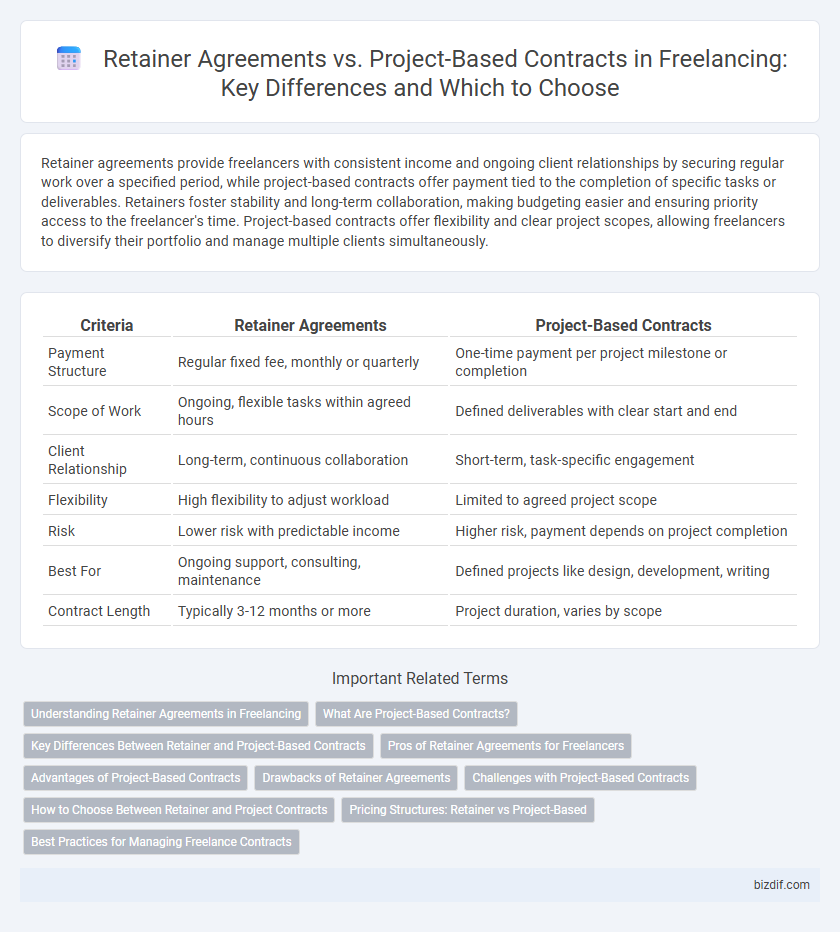Retainer agreements provide freelancers with consistent income and ongoing client relationships by securing regular work over a specified period, while project-based contracts offer payment tied to the completion of specific tasks or deliverables. Retainers foster stability and long-term collaboration, making budgeting easier and ensuring priority access to the freelancer's time. Project-based contracts offer flexibility and clear project scopes, allowing freelancers to diversify their portfolio and manage multiple clients simultaneously.
Table of Comparison
| Criteria | Retainer Agreements | Project-Based Contracts |
|---|---|---|
| Payment Structure | Regular fixed fee, monthly or quarterly | One-time payment per project milestone or completion |
| Scope of Work | Ongoing, flexible tasks within agreed hours | Defined deliverables with clear start and end |
| Client Relationship | Long-term, continuous collaboration | Short-term, task-specific engagement |
| Flexibility | High flexibility to adjust workload | Limited to agreed project scope |
| Risk | Lower risk with predictable income | Higher risk, payment depends on project completion |
| Best For | Ongoing support, consulting, maintenance | Defined projects like design, development, writing |
| Contract Length | Typically 3-12 months or more | Project duration, varies by scope |
Understanding Retainer Agreements in Freelancing
Retainer agreements in freelancing secure ongoing client commitment by providing regular, pre-paid access to services, ensuring steady income and prioritized availability. These contracts define a set number of hours or deliverables per month, enabling freelancers to balance workload and maintain cash flow predictability. Unlike project-based contracts, retainers emphasize continuous collaboration, fostering long-term client relationships and streamlined workflow management.
What Are Project-Based Contracts?
Project-based contracts define specific deliverables, timelines, and payment terms tied to the completion of a particular project, offering clear scope and budget control for freelancers and clients. These agreements emphasize a one-time engagement, often suitable for tasks with distinct objectives and measurable outcomes. Freelancers benefit from structured milestones, while clients gain predictable costs and defined project expectations.
Key Differences Between Retainer and Project-Based Contracts
Retainer agreements guarantee ongoing access to a freelancer's services for a fixed monthly fee, providing consistent income and priority availability, while project-based contracts are defined by specific deliverables and timelines with payment tied to completion milestones. Retainers emphasize long-term collaboration and flexibility, enabling agile adjustments to scope, whereas project-based contracts focus on clearly outlined objectives and finite engagement periods. Understanding these differences helps freelancers manage cash flow, client relationships, and workload expectations effectively.
Pros of Retainer Agreements for Freelancers
Retainer agreements provide freelancers with steady, predictable income by securing ongoing client engagements, enhancing financial stability and cash flow management. These agreements foster stronger client relationships through continuous collaboration, increasing trust and potential for long-term work. Retainers reduce administrative time spent on negotiations and new contract setups, allowing freelancers to focus more on delivering quality services.
Advantages of Project-Based Contracts
Project-based contracts offer clear deliverables and defined timelines, enabling freelancers to manage their workload efficiently and clients to anticipate project completion. This contract type reduces payment ambiguities by specifying fixed costs tied to project milestones, enhancing financial predictability for both parties. Freelancers benefit from the flexibility to diversify their client base and projects, avoiding long-term commitments associated with retainer agreements.
Drawbacks of Retainer Agreements
Retainer agreements can limit flexibility as clients may be locked into paying a fixed fee regardless of workload fluctuations, potentially leading to underutilization or overpayment. These contracts often lack clear deliverables, making performance measurement difficult and causing disputes over the scope of work. Freelancers may also face cash flow challenges if clients delay payments despite ongoing commitments under the retainer.
Challenges with Project-Based Contracts
Project-based contracts often create cash flow challenges for freelancers due to irregular payment schedules tied to milestones or completion. They can lead to scope creep without clear boundaries, causing extra unpaid work and strained client relationships. Tracking time and managing client expectations become complex, increasing the likelihood of disputes and delayed payments.
How to Choose Between Retainer and Project Contracts
Evaluate the scope and duration of work when choosing between retainer and project contracts in freelancing; retainer agreements suit ongoing, consistent work requiring steady availability, while project-based contracts are ideal for one-time assignments with defined deliverables. Consider cash flow stability--retainers provide predictable monthly income, whereas project contracts offer payment upon milestone or completion. Assess client relationship depth and workload flexibility to determine which contract type aligns best with your business goals and resource capacity.
Pricing Structures: Retainer vs Project-Based
Retainer agreements provide consistent monthly income through fixed fees, enhancing financial stability for freelancers by covering ongoing services or guaranteed hours. Project-based contracts offer variable pricing tied to specific deliverables, enabling flexible budgeting but potentially causing income fluctuations. Choosing between these pricing structures depends on the freelancer's preference for predictable revenue versus adaptability to project scope and client needs.
Best Practices for Managing Freelance Contracts
Prioritize clarity by defining scope, deliverables, deadlines, and payment terms explicitly in both retainer agreements and project-based contracts. Regular communication and documented approvals prevent scope creep and ensure alignment between freelancers and clients. Employing detailed contracts with dispute resolution clauses safeguards both parties and fosters long-term professional relationships.
retainer agreements vs project-based contracts Infographic

 bizdif.com
bizdif.com